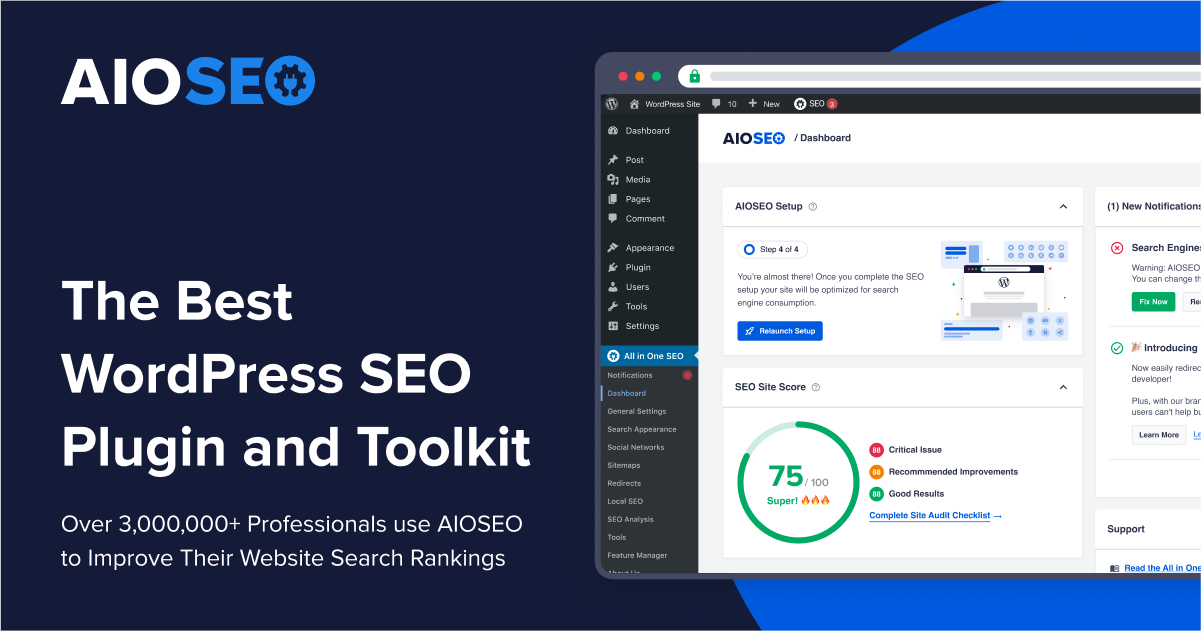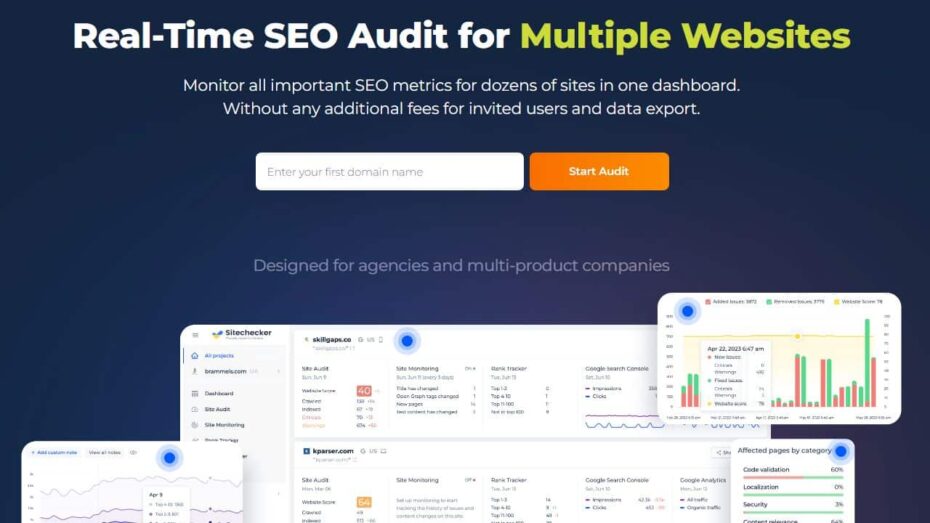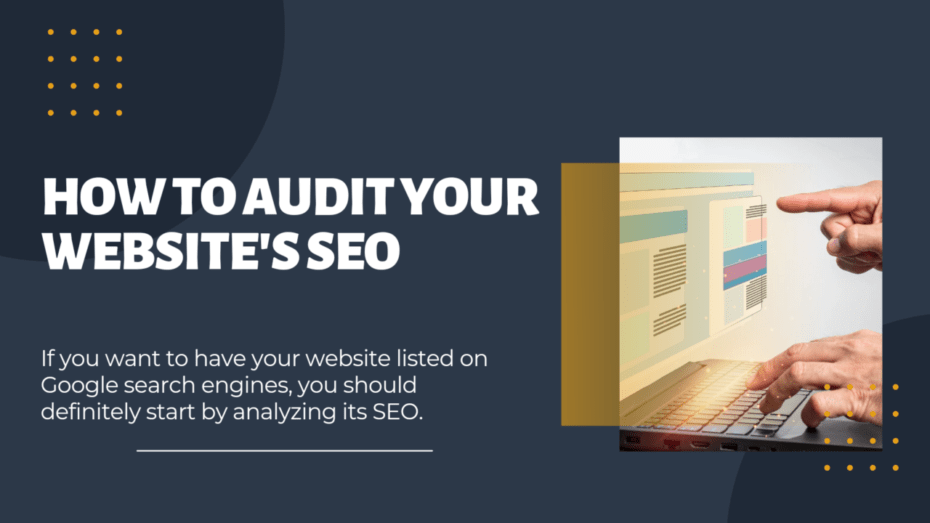Table of Contents
How to audit your website effectively? Are you missing crucial SEO elements that could boost your rankings? In this guide, we’ll delve into comprehensive steps and strategies to audit your website’s SEO easily.
Understanding the Basics of Website Audits
Website audits are fundamental to ensuring your site is optimized for search engines and user experience. By understanding the basics of website audits, you can maintain a healthy online presence and stay ahead of competitors. Regular audits help identify issues that may be hindering your website’s performance, allowing for timely corrections and improvements.
Performing a website audit involves examining various elements, from technical aspects to content quality. Each component plays a crucial role in your site’s overall SEO health. With a thorough understanding of these basics, you can effectively audit your website and enhance its performance.
SEO Services Recommendations
 AIOSEO
|  Sitechecker
|  Squirrly
|
What is an SEO Audit?
An SEO audit is a comprehensive evaluation of your website’s ability to appear in search engine results. It assesses various factors, including on-page and off-page elements, technical setup, and content. This process helps identify areas where your site can improve to boost its visibility and ranking.
The purpose of an SEO audit is to uncover any issues that might be affecting your site’s performance. This could range from broken links and slow page speeds to poorly optimized content. By addressing these issues, you can improve your website’s user experience and search engine rankings.
During an SEO audit, you will analyze your site’s structure, keywords, and backlinks. Tools such as Google Analytics and Google Search Console are often used to gather data and insights. Regular audits ensure your website remains aligned with search engine algorithms and industry best practices.
Moreover, an SEO audit provides a roadmap for making strategic improvements. By understanding your site’s strengths and weaknesses, you can prioritize tasks that will have the most significant impact on your SEO performance. This ongoing process is vital for maintaining and enhancing your online presence.
Why Regular SEO Audits are Important
Regular SEO audits are crucial for staying competitive and ensuring your website is performing at its best. Search engines frequently update their algorithms, and your site needs to adapt to these changes to maintain its ranking. Consistent audits help you stay proactive rather than reactive to these updates.
Conducting regular audits allows you to identify and fix issues promptly. For instance, you might discover broken links or outdated content that could negatively impact your user experience and SEO efforts. By addressing these problems, you enhance your site’s functionality and attractiveness to visitors.
Another key benefit of regular SEO audits is staying ahead of your competition. As other businesses improve their SEO strategies, you need to ensure your site is also optimized. Regular audits provide insights into what your competitors are doing and help you adjust your tactics accordingly.
In addition, these audits help track the effectiveness of your SEO strategies. By regularly reviewing your site’s performance, you can see which efforts are yielding results and which need adjustment. This ongoing evaluation is essential for refining your approach and achieving long-term success.
Key Components of an Effective Audit
An effective SEO audit covers several key components that together form a complete picture of your website’s performance. These components include technical SEO, on-page SEO, off-page SEO, and user experience. Each area requires detailed analysis to ensure your site is fully optimized.
Technical SEO focuses on the backend elements of your site, such as page speed, mobile-friendliness, and crawlability. Ensuring your site is technically sound helps search engines index your content efficiently and provides a better user experience. Regular checks on your site’s technical health are vital for sustained performance.
On-page SEO examines elements like title tags, meta descriptions, and keyword usage within your content. Properly optimized on-page elements ensure that your content is relevant to the search queries your audience uses. This component also includes improving content quality and structure to enhance readability and engagement.
Off-page SEO involves analyzing your backlink profile and overall online presence. High-quality backlinks from reputable sources boost your site’s authority and search engine ranking. Monitoring and improving your off-page SEO ensures you build a strong and credible online reputation.
Lastly, user experience (UX) is a critical component of an SEO audit. A positive UX keeps visitors engaged and reduces bounce rates. Factors like website design, navigation, and content accessibility all contribute to a seamless user experience. Prioritizing UX in your audit helps retain visitors and encourages return traffic.
Setting Clear SEO Audit Goals
Setting clear SEO audit goals is essential for a successful and efficient audit process. Knowing what you aim to achieve helps focus your efforts and ensures that your website audit is both thorough and targeted. Whether you’re looking to improve site speed, enhance content quality, or boost search engine rankings, having defined goals will guide your audit strategy effectively.
When setting your SEO audit goals, consider your overall business objectives and how your website contributes to them. Aligning your audit goals with your business goals ensures that the improvements you make will have a meaningful impact. Clear goals also make it easier to measure success and track progress over time.
Identifying Your Website’s Objectives
Identifying your website’s objectives is the first step in setting effective SEO audit goals. Ask yourself what you want your website to achieve. Are you aiming to increase traffic, generate leads, or enhance user engagement? Clearly defining these objectives will help shape your audit focus and ensure your efforts are aligned with your business needs.
Understanding your website’s purpose is crucial. For instance, an e-commerce site will have different goals compared to a blog or a corporate site. An e-commerce site might prioritize conversion rate optimization and user experience, while a blog might focus on content quality and audience engagement. Tailoring your audit goals to your specific website type will yield better results.
Once you have a clear understanding of your objectives, translate them into specific, measurable goals. For example, if your objective is to increase traffic, a goal might be to boost organic search traffic by 20% over the next six months. Specific goals provide a clear target to aim for and make it easier to evaluate the success of your audit.
Regularly reviewing and updating your website’s objectives is also important. As your business evolves, your website’s goals may change. Keeping your objectives current ensures that your SEO audit goals remain relevant and aligned with your overall strategy. This continuous alignment is key to maintaining a successful online presence.
Defining Success Metrics
Defining success metrics is essential for measuring the effectiveness of your SEO audit. Success metrics provide tangible indicators of progress and help you understand the impact of your efforts. Without clear metrics, it’s challenging to determine whether your audit is successful or identify areas that need improvement.
Start by identifying key performance indicators (KPIs) that align with your SEO goals. Common KPIs include organic traffic, bounce rate, conversion rate, and keyword rankings. These metrics offer insights into different aspects of your website’s performance and help you track the success of your SEO strategies.
It’s important to set specific, achievable targets for each KPI. For instance, if your goal is to improve page speed, you might set a target to reduce average load time by 30%. Having concrete targets gives you a clear benchmark to strive for and makes it easier to measure success.
Regularly monitoring your success metrics is crucial for ongoing optimization. Use tools like Hotjar and Woopra to track your KPIs and gain insights into your website’s performance. Analyzing this data helps you identify trends, spot issues early, and make data-driven decisions to improve your SEO efforts.
Finally, be prepared to adjust your success metrics as needed. As you achieve your initial targets and your business evolves, your metrics may need to change. Staying flexible and updating your success metrics ensures that they remain relevant and continue to drive meaningful improvements.
Setting a Timeline for Regular Audits
Setting a timeline for regular audits is vital for maintaining your website’s SEO health. Regular audits help you stay on top of changes in search engine algorithms, industry trends, and your own website’s performance. Establishing a consistent audit schedule ensures that your site remains optimized and competitive.
Begin by determining how frequently you should conduct SEO audits. While the ideal frequency can vary depending on your website’s size and complexity, a good starting point is to perform audits quarterly. Quarterly audits provide a balance between keeping your site updated and not overwhelming your resources.
Create a detailed audit schedule that outlines specific tasks and deadlines. Breaking down the audit process into manageable steps makes it easier to stay organized and ensures that all critical areas are covered. Assigning deadlines for each task helps keep the audit on track and prevents procrastination.
In addition to regular audits, consider scheduling mini-audits or specific checks in between major audits. For example, you might perform a monthly check of your site’s speed and performance or a bi-weekly review of your keyword rankings. These smaller, focused audits can help catch issues early and keep your site running smoothly.
Lastly, ensure that you have the necessary resources and tools in place for your audits. Having a dedicated team or individual responsible for SEO audits, along with the right tools, will make the process more efficient and effective. With a well-defined timeline and the right support, you can maintain a robust and optimized website.
Conducting a Technical SEO Audit
Conducting a technical SEO audit is crucial for ensuring your website functions efficiently and meets search engine requirements. A thorough technical audit helps identify and rectify issues that could hinder your site’s performance, ultimately improving your search rankings and user experience.
During a technical SEO audit, focus on aspects like site speed, mobile-friendliness, crawlability, and broken links. Addressing these technical elements ensures your website remains accessible, fast, and user-friendly, which are essential factors for maintaining a strong online presence.
Checking Website Speed and Performance
Website speed and performance are critical components of a successful SEO strategy. A fast-loading site improves user experience and is favored by search engines, which can positively impact your rankings. Tools like Google PageSpeed Insights and GTmetrix can help you analyze and optimize your site speed.
Start by measuring your website’s current load times and identifying elements that cause delays. Large images, excessive scripts, and poorly optimized code are common culprits. Compressing images, minifying CSS and JavaScript, and leveraging browser caching can significantly enhance your site’s speed and performance.
Moreover, consider using a content delivery network (CDN) to distribute your website’s content across multiple servers globally. This reduces latency and improves load times for users regardless of their geographical location. Consistently monitoring and optimizing your site speed is essential for maintaining a competitive edge.
Remember, a slow website can lead to higher bounce rates and lower conversion rates. Ensuring your site loads quickly not only keeps visitors engaged but also encourages them to explore more pages, ultimately leading to better user satisfaction and improved SEO outcomes.
Ensuring Mobile-Friendliness
Ensuring mobile-friendliness is essential as more users access websites from mobile devices. A mobile-friendly site provides a seamless user experience, which is crucial for retaining visitors and improving search engine rankings. Bing’s Mobile Friendliness Test Tool can help you evaluate your site’s mobile compatibility.
Begin by checking if your website uses responsive design, which adjusts the layout based on the device’s screen size. A responsive design ensures that content is easily readable and navigation is intuitive on mobile devices. Mobile-friendly sites are prioritized by search engines, making this an important aspect of your technical SEO audit.
Next, evaluate the usability of your site’s mobile version. Ensure buttons and links are easy to click, text is legible without zooming, and images scale properly. Simplifying your site’s design and eliminating unnecessary elements can enhance the mobile user experience.
Additionally, consider the loading speed of your mobile site. Mobile users expect fast load times, so optimizing for speed is crucial. Techniques like reducing server response times, enabling compression, and optimizing images for mobile can improve your site’s performance on mobile devices.
Finally, regularly test your site on various mobile devices and browsers to ensure consistent performance. Keeping your site mobile-friendly will attract more visitors, reduce bounce rates, and contribute to higher search engine rankings.
Analyzing Crawlability and Indexability
Analyzing crawlability and indexability is a vital part of a technical SEO audit. Crawlability refers to how easily search engine bots can access and crawl your website’s content, while indexability determines whether that content can be indexed in search engine databases. Tools like Google Search Console provide valuable insights into these aspects.
Start by checking your site’s robots.txt file to ensure it is not blocking important pages from being crawled. This file guides search engine bots on which pages to crawl and index. Incorrect configurations can prevent search engines from accessing critical content, negatively impacting your SEO.
Next, review your site’s XML sitemap. An XML sitemap helps search engines discover and index your pages more efficiently. Ensure your sitemap is up-to-date and includes all relevant pages. Submitting your sitemap to search engines can enhance your site’s crawlability and indexability.
Monitor crawl errors reported in Google Search Console. These errors indicate issues that prevent search engines from accessing your content. Addressing errors like 404 pages, server errors, and redirect issues ensures that bots can crawl and index your site without hindrance.
Lastly, evaluate your site’s internal linking structure. Effective internal linking helps search engines discover new content and understand the relationship between pages. Ensure your site has a logical hierarchy and that all important pages are easily accessible through internal links.
Fixing Broken Links and Errors
Fixing broken links and errors is essential for maintaining a healthy website. Broken links lead to poor user experience and can negatively impact your SEO performance. Regularly auditing your site for broken links and fixing them ensures a seamless experience for your visitors and helps maintain search engine rankings.
Use tools like Screaming Frog and Ahrefs to identify broken links on your website. These tools can crawl your site and provide a list of broken links, missing pages, and other errors. Once identified, you can prioritize and address these issues promptly.
For internal links, ensure that all links point to the correct URLs and that no pages return a 404 error. Redirect broken links to relevant pages using 301 redirects to preserve link equity and improve user experience. Regularly updating and checking your internal links helps keep your site navigable and user-friendly.
In addition to internal links, monitor external links on your site. External links pointing to broken or outdated pages can harm your site’s credibility and user experience. Replace or remove broken external links to ensure your content remains valuable and reliable.
Finally, keep an eye on server errors and other technical issues that may arise. Regularly reviewing your site’s error logs and addressing any server issues promptly ensures that your site remains functional and accessible to both users and search engine bots.
On-Page SEO Elements to Review
On-page SEO elements are critical for optimizing your website and improving search engine visibility. These elements include title tags, meta descriptions, content quality, and internal linking structure. Reviewing and optimizing these components ensures your site is relevant, engaging, and easy to navigate.
Focusing on on-page SEO helps search engines understand your content and match it with user queries. Regularly reviewing these elements keeps your site updated and aligned with SEO best practices, ultimately driving more organic traffic to your website.
Optimizing Title Tags and Meta Descriptions
Optimizing title tags and meta descriptions is vital for improving your site’s click-through rates and search engine rankings. Title tags are the first impression users get of your page, while meta descriptions provide a brief summary of the content. Both elements should be compelling and relevant to the primary keyword.
Ensure your title tags are unique for each page and include the primary keyword naturally. Keep them within 60 characters to prevent truncation in search results. A well-crafted title tag attracts users’ attention and encourages them to click through to your site.
Meta descriptions should be concise, informative, and include the primary keyword. Aim for a length of 150-160 characters to provide enough detail without getting cut off. A strong meta description entices users to visit your site and gives them a clear idea of what to expect.
Additionally, avoid duplicating title tags and meta descriptions across multiple pages. Each page should have its own unique and relevant tags to maximize SEO potential. Regularly review and update these elements to ensure they reflect the current content and focus of your pages.
Testing different variations of title tags and meta descriptions can also help determine what resonates best with your audience. Analyzing performance metrics like click-through rates can provide insights into what works and where improvements are needed.
Improving Content Quality and Relevance
Improving content quality and relevance is essential for engaging your audience and boosting your search engine rankings. High-quality content that addresses user intent and provides valuable information is more likely to attract and retain visitors. Focus on creating comprehensive, well-researched, and original content.
Start by understanding your target audience and their needs. Conduct keyword research to identify relevant topics and incorporate the primary keyword naturally throughout your content. Avoid keyword stuffing and ensure that your content reads naturally and provides genuine value.
Structure your content with clear headings, subheadings, and bullet points to enhance readability. Breaking down information into digestible sections makes it easier for users to find what they’re looking for and improves their overall experience. Visual elements like images and videos can also enhance content quality.
Regularly update your content to keep it current and relevant. Outdated information can harm your credibility and reduce user trust. Refreshing your content with the latest data, trends, and insights ensures it remains useful and engaging for your audience.
Lastly, encourage user interaction and feedback. Adding comments sections, social sharing buttons, and interactive elements can boost engagement and provide additional insights into what your audience finds valuable. High-quality, relevant content not only improves SEO but also builds a loyal and engaged audience.
Enhancing Internal Linking Structure
Enhancing your internal linking structure is crucial for improving navigation and SEO. Internal links help search engines understand the hierarchy and relationship between pages on your site. They also guide users to related content, increasing their engagement and time spent on your site.
Begin by mapping out your site’s structure and identifying key pages. Ensure that important pages are easily accessible from your homepage and other high-traffic areas. A logical and organized linking structure makes it easier for users and search engines to navigate your site.
Use descriptive anchor text for internal links to provide context and relevance. Avoid generic terms like “click here” and instead use keywords that describe the linked content. This helps search engines understand the content of the linked page and improves your SEO.
Regularly review and update your internal links to ensure they remain relevant and functional. Remove or replace broken links and update any outdated links to reflect your current content. Keeping your internal linking structure up-to-date enhances user experience and search engine crawling efficiency.
Consider creating a comprehensive internal linking strategy that includes linking to older, high-performing content. This can boost the visibility of your older posts and distribute link equity throughout your site. An effective internal linking structure supports both user navigation and SEO efforts.
Off-Page SEO Factors to Consider
When auditing your website’s SEO, off-page factors are just as crucial as on-page elements. Off-page SEO focuses on building your website’s authority and credibility through external means, such as backlinks and social signals. By optimizing these factors, you can significantly enhance your site’s visibility and rankings in search engine results.
Understanding and implementing effective off-page SEO strategies can drive more organic traffic to your website. This involves not only acquiring high-quality backlinks but also actively engaging with your audience on social media platforms. Let’s explore the key off-page SEO factors to consider for a comprehensive SEO audit.
Assessing Backlink Profile
Assessing your backlink profile is essential for understanding how external sites link to your content. A robust backlink profile with links from authoritative, relevant websites can significantly boost your search engine rankings. Use tools like Ahrefs or Moz to analyze your current backlinks and identify areas for improvement.
Start by examining the quality of your backlinks. High-quality backlinks come from reputable websites with strong domain authority. These links are more valuable than numerous low-quality links from irrelevant or spammy sites. Prioritize earning backlinks from sites within your industry or niche to enhance relevance.
Next, analyze the anchor text used in your backlinks. Diverse, natural-sounding anchor text is preferable as it appears more organic to search engines. Avoid excessive use of exact-match keywords in your anchor texts, as this can be seen as manipulative and may lead to penalties.
Identify and disavow toxic backlinks that could harm your site’s reputation. These include links from spammy or low-quality websites. Using Google’s Disavow Tool can help you remove these detrimental links and protect your site’s SEO health. Regularly monitoring your backlink profile ensures it remains strong and beneficial.
Building High-Quality Links
Building high-quality links is a critical aspect of off-page SEO. Quality backlinks signal to search engines that your website is a trusted and valuable resource. To acquire these links, focus on creating compelling content that others want to reference and share.
Guest blogging is a popular strategy for building high-quality links. By contributing valuable content to reputable blogs within your niche, you can earn backlinks while also reaching a broader audience. Ensure your guest posts are informative and relevant to the host site’s audience to maximize their impact.
Another effective method is outreach to industry influencers and bloggers. Share your content with them and explain why it would be valuable to their audience. If they find your content useful, they may link to it from their own websites or social media channels, enhancing your backlink profile.
Creating shareable content, such as infographics, research studies, and comprehensive guides, can naturally attract backlinks. When people find your content valuable, they are more likely to link to it from their own websites. Promoting your content through social media and email marketing can further increase its reach and backlink potential.
Monitoring Social Signals and Engagement
Monitoring social signals and engagement is another important off-page SEO factor. Social signals, such as likes, shares, and comments, can indirectly influence your search engine rankings. Engaging with your audience on social media platforms can boost your website’s visibility and credibility.
Start by identifying the social media platforms where your target audience is most active. Focus your efforts on building a strong presence on these platforms. Share valuable content regularly and encourage your audience to engage with your posts. Higher engagement levels can lead to increased visibility and more traffic to your site.
Use social media analytics tools to track your performance and understand what types of content resonate most with your audience. Analyzing metrics like reach, engagement, and click-through rates can help you refine your social media strategy and create content that drives more interactions.
Additionally, actively participate in relevant online communities and forums. Sharing your expertise and providing valuable insights can establish you as a thought leader in your industry. This not only builds your online reputation but also attracts more visitors to your website, potentially leading to more backlinks and improved SEO.
Remember, consistency is key. Regularly interacting with your audience and providing valuable content fosters a loyal community that supports your website’s growth. Social signals and engagement can amplify your SEO efforts and contribute to long-term success.
Using SEO Tools for an Efficient Audit
Using SEO tools for an efficient audit streamlines the process and provides valuable insights into your website’s performance. These tools help identify issues, track progress, and optimize your SEO strategy effectively. Incorporating the right tools into your audit can save time and ensure a thorough evaluation.
SEO tools come in various forms, each designed to address different aspects of your audit. From technical analysis to content and keyword research, these tools offer comprehensive data to enhance your website’s SEO. Let’s explore some recommended tools for an efficient SEO audit.
Recommended Tools for Technical Analysis
Technical analysis is a critical component of an SEO audit, and several tools can help streamline this process. Google Search Console is a must-have for any website owner, offering insights into crawl errors, indexing issues, and overall site performance. It also provides data on search queries and click-through rates.
Another essential tool is Screaming Frog, which crawls your website to identify technical issues like broken links, duplicate content, and missing meta tags. This tool provides a comprehensive overview of your site’s structure and helps pinpoint areas that need improvement.
GTmetrix and Google PageSpeed Insights are valuable for analyzing website speed and performance. These tools offer detailed reports on load times, performance scores, and recommendations for optimization. Addressing speed issues can enhance user experience and boost your search engine rankings.
Sitechecker Audit is another robust tool that provides an in-depth analysis of your website’s technical health. It highlights critical issues, assesses your site’s structure, and offers actionable recommendations. Regular use of these tools ensures your site remains technically sound and optimized.
Tools for Content and Keyword Analysis
Content and keyword analysis are vital for optimizing your website’s relevance and search engine visibility. Tools like SEMrush and Squirrly offer extensive keyword research capabilities, helping you identify high-performing keywords and track your rankings over time.
Google Analytics is indispensable for understanding how users interact with your content. It provides insights into user behavior, including page views, session duration, and bounce rates. This data helps you identify which content resonates with your audience and where improvements are needed.
Surfer SEO is a powerful tool for optimizing your content based on top-ranking pages. It analyzes the content structure, keyword usage, and other on-page elements of high-ranking pages, offering suggestions to enhance your own content. This ensures your content aligns with current SEO best practices.
Additionally, tools like Grammarly and Hemingway Editor can improve content quality. These tools help refine your writing, making it clearer and more engaging. High-quality, relevant content is crucial for attracting and retaining visitors, as well as improving your SEO.
Utilizing Competitor Analysis Tools
Competitor analysis tools provide valuable insights into your competitors’ strategies, helping you identify opportunities and stay ahead. Tools like Ahrefs and SEMrush offer competitor analysis features that reveal their backlink profiles, top-performing content, and keyword rankings.
Start by identifying your main competitors and analyzing their websites. Look at their content, keyword usage, and backlink sources. Understanding what works for them can inform your own SEO strategy and help you uncover gaps or areas for improvement on your site.
SpyFu is another useful tool that provides insights into your competitors’ paid and organic search strategies. It reveals the keywords they target, their ad performance, and their top-ranking content. This information can guide your own keyword strategy and help you optimize your SEO efforts.
Lastly, BuzzSumo allows you to analyze the most shared content in your niche. This tool highlights popular topics and content formats, helping you create engaging and shareable content. Monitoring your competitors’ social media performance can also provide ideas for your own content strategy.
Regularly utilizing competitor analysis tools keeps you informed about industry trends and competitive dynamics. This proactive approach ensures you can adapt and refine your SEO strategy to maintain a competitive edge.
Creating an SEO Audit Report
Creating an SEO audit report is a crucial step in understanding your website’s current performance and identifying areas for improvement. An effective audit report documents your findings, offers actionable recommendations, and serves as a roadmap for enhancing your site’s SEO. This report not only helps you keep track of your SEO efforts but also communicates the state of your website to stakeholders.
An SEO audit report should be detailed yet easy to understand, highlighting key issues and suggesting practical solutions. It should cover various aspects of your website, including technical SEO, on-page and off-page elements, and user experience. Let’s explore how to document your findings and recommendations effectively, prioritize issues, and track your progress.
Documenting Findings and Recommendations
Documenting findings and recommendations is the foundation of your SEO audit report. Start by presenting a clear overview of your website’s current SEO performance, using data and insights gathered from various SEO tools. Highlight critical issues, such as broken links, slow page speeds, or weak content, and explain their impact on your site’s performance.
Provide detailed recommendations for each identified issue. For example, if you find that your site has numerous broken links, recommend specific steps to fix them, such as updating URLs or setting up 301 redirects. Ensure that your recommendations are actionable and easy to follow, enabling your team to implement changes efficiently.
Visual aids like charts, graphs, and screenshots can make your report more engaging and easier to understand. Use these tools to illustrate your findings and recommendations clearly. For instance, a graph showing your site’s load times before and after optimization can effectively demonstrate the impact of your efforts.
Finally, organize your report logically, with sections dedicated to different aspects of your audit, such as technical SEO, content quality, and backlink profile. This structure makes it easier for readers to navigate the report and find the information they need.
Prioritizing Issues and Action Steps
Prioritizing issues and action steps is essential for addressing the most critical problems first and ensuring efficient use of resources. Begin by categorizing issues based on their impact on your website’s performance and their urgency. High-impact issues that significantly affect your rankings or user experience should be addressed immediately.
Create a prioritized action plan that outlines the steps needed to resolve each issue. Assign responsibilities to specific team members and set clear deadlines for each task. This ensures accountability and helps keep the audit process on track. For example, you might prioritize fixing critical technical issues like broken links and slow page speeds before optimizing meta tags and descriptions.
Additionally, consider the resources and time required to address each issue. Some fixes may be quick and easy, while others might require more extensive efforts. Balancing high-impact quick wins with longer-term projects can help maintain momentum and demonstrate progress to stakeholders.
Regularly review and adjust your priorities as needed. As you address initial issues, new ones may arise, or the impact of existing problems may change. Staying flexible and responsive ensures that your SEO efforts remain focused and effective.
Tracking Progress and Adjusting Strategies
Tracking progress and adjusting strategies is vital for the continuous improvement of your SEO efforts. Use tools like Google Analytics and Google Search Console to monitor the impact of your changes and measure your website’s performance over time. Regularly reviewing these metrics helps you understand what’s working and where further adjustments are needed.
Set up key performance indicators (KPIs) to measure the success of your SEO strategies. Common KPIs include organic traffic, bounce rate, conversion rate, and keyword rankings. Tracking these metrics provides valuable insights into the effectiveness of your SEO efforts and highlights areas for improvement.
Analyze the data collected to identify trends and patterns. For example, if you notice a significant increase in organic traffic after implementing content optimizations, this indicates that your strategies are working. Conversely, if certain changes do not yield the expected results, be prepared to adjust your approach.
Regularly update your SEO audit report with new findings and progress updates. This keeps stakeholders informed and ensures that everyone is aligned with the current state of your website’s SEO. Continuous monitoring and strategy adjustments help maintain and enhance your site’s performance over time.
Implementing and Monitoring SEO Changes
Implementing and monitoring SEO changes is an ongoing process that requires careful planning and execution. Once you have identified and prioritized issues through your SEO audit, it’s time to put your action plan into motion. This involves making data-driven adjustments, continuously monitoring performance, and conducting periodic re-audits to ensure sustained success.
Effective implementation of SEO changes requires a coordinated effort from your team. Assign specific tasks to team members based on their expertise and ensure that everyone understands their responsibilities. Regular communication and progress updates help keep the project on track and ensure timely completion of tasks.
Making Data-Driven Adjustments
Making data-driven adjustments is key to optimizing your website’s SEO performance. Use the insights gathered from your SEO audit and monitoring tools to guide your decisions. For example, if data shows that certain keywords drive significant traffic, focus on optimizing content around those keywords.
Prioritize changes that have the highest potential impact on your site’s performance. For instance, improving page load speed and fixing technical issues often yield significant benefits. Data-driven adjustments ensure that your efforts are targeted and effective, maximizing the return on your SEO investment.
Regularly test the effectiveness of your changes. A/B testing different elements, such as meta descriptions, headlines, and call-to-action buttons, can provide valuable insights into what works best for your audience. Use the results of these tests to refine your strategies and further optimize your site.
Document all changes made and the rationale behind them. This helps track progress and provides a reference for future audits. Keeping detailed records also enables you to evaluate the long-term impact of your adjustments and identify areas for continuous improvement.
Continuous Monitoring and Improvement
Continuous monitoring and improvement are essential for maintaining and enhancing your website’s SEO performance. Use tools like Google Analytics, Google Search Console, and SEMrush to track key metrics and identify areas that need attention. Regularly reviewing these metrics helps you stay informed about your site’s performance and respond to changes promptly.
Set up automated alerts for critical issues, such as sudden drops in traffic or increases in error rates. These alerts enable you to address problems quickly before they have a significant impact on your site’s performance. Proactive monitoring helps maintain a high level of SEO health.
Encourage a culture of continuous improvement within your team. Regularly review and discuss your SEO strategies, celebrate successes, and learn from setbacks. Staying committed to ongoing optimization ensures that your website remains competitive and aligned with best practices.
Stay informed about industry trends and updates to search engine algorithms. Search engines continuously evolve, and staying up-to-date with these changes is crucial for maintaining your SEO success. Engaging with the SEO community and participating in relevant forums and conferences can provide valuable insights and keep your strategies current.
Periodic Re-Audits for Sustained Success
Periodic re-audits are essential for sustaining long-term SEO success. Regularly auditing your website ensures that you identify and address new issues as they arise and adapt to changes in search engine algorithms. Schedule re-audits at least quarterly to maintain optimal performance.
Each re-audit should follow a structured process similar to your initial audit. Review all aspects of your site, including technical SEO, content quality, and backlink profile. Compare the findings to previous audits to track progress and identify recurring issues.
Use the insights gained from re-audits to refine your SEO strategies. Update your action plans based on new findings and prioritize tasks that will have the most significant impact. Continuous improvement driven by regular audits helps maintain a competitive edge and enhances your site’s performance.
Communicate the results of re-audits to stakeholders, highlighting progress and areas that need attention. Keeping everyone informed ensures that your team remains aligned and committed to your SEO goals. Periodic re-audits provide a roadmap for sustained success and ongoing optimization.






